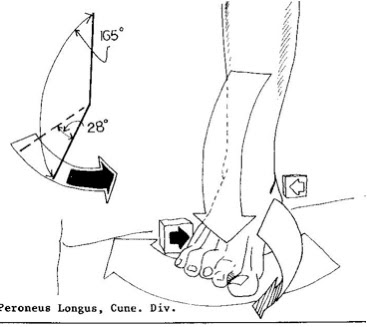As discussed in 'Reciprocal Implications At Play In Gait', we need to have a good
foot-ground relationship to create a biomechanically appropriate blueprint for
movement. Quite frequently aberrant development in the womb and in the first 4
years of life leaves the adult with a few bony malalignments or functional
insufficiencies. When these deviations from ideal are in the foot, leg, or hip
they can greatly disturb the foot-ground relationship and set off a cascade of
poor neuromuscular control.
Here is a pedograph of a poor foot-ground relationship. We
see an uncompensated forefoot varus, increased pronation, and slew of other
findings in the foot.
There are two obvious ways to solve this problem.
2)
Improve neurologic control of the foot to meet the ground in a better way.
The hotly debated topic of foot orthotics will be discussed
in a later post, but for now lets focus on improving the control of the foot.
When a patient cannot achieve a firm base of support under
the 1st mpj they will be at risk for hallux abducto-valgus, bunion
formation, hyper-pronation injuries, and the list goes on. One of the muscles
that helps to create the medial tripod is peroneus longus. The peroneus longus
plantar flexes and everts the ankle, and based on its distal attachment also
strongly plantar flexes the first mpj to support the medial tripod. When this
muscle is not functioning properly we see a weak medial tripod, hyper
pronation, genu valgum, and increased occurrence of inversion ankle sprains.
To test if the strength of the peroneus longus- completely
plantarflex, abduct and evert the foot. While bracing the calcaneus and
contacting the lateral foot, try to invert and adduct the foot against the
patient’s resistance.
A great exercise we use to get the peroneus longus firing is called the peronei pump and is demonstrated in the video below.
This exercise requires the patient to put the peroneus longus muscle into its shortest and strongest position (plantarflextion/abduction/eversion
of the foot with plantarflexion of the 1st mpj). The foot is then
slowly pumped between full plantarflexion and full dorsiflexion while all other
values are maintained. If done correctly, the patient will feel a deep ache in
the lateral leg as the peronei musculature clears fascial restrictions,
activates full contraction, and eventually fatigues. This is typically achieved
within the first 10-20 repetitions or within 1 minute. By doing a peronei pump
exercise a few times daily, the muscle becomes easier to access in all phases
of gait. This is not a perfect representation of the peronei function during
gait, so further “gait training” may be needed to incorporate the mighty mighty
peronei.










